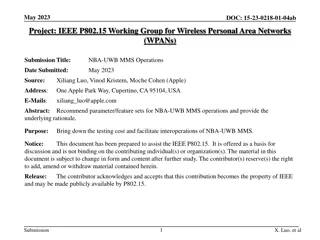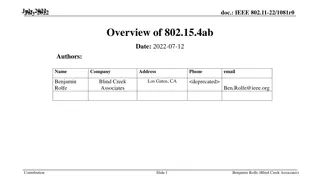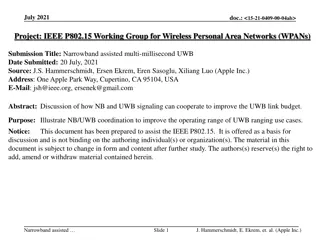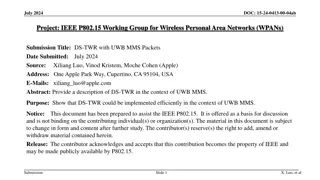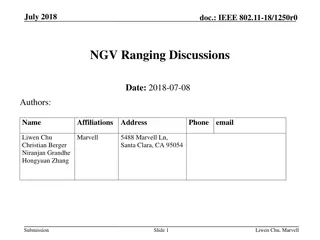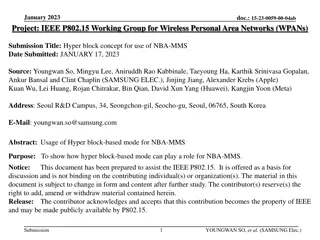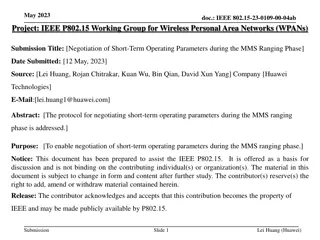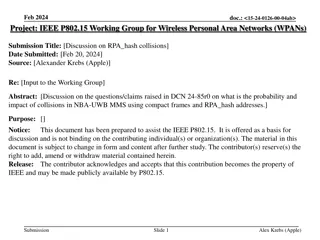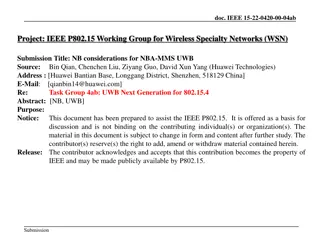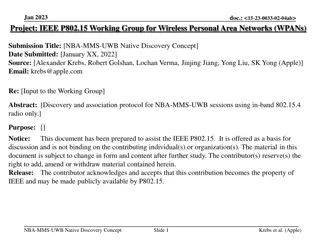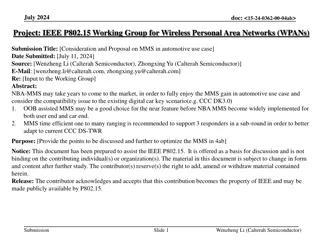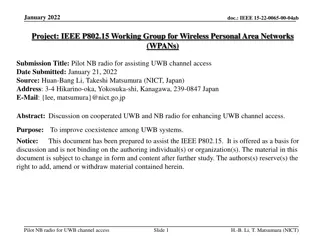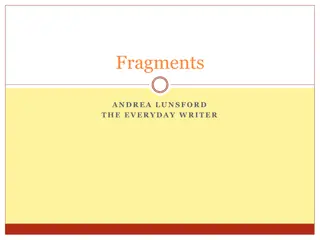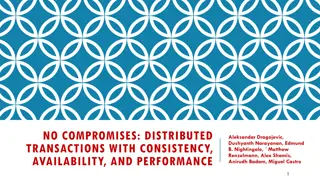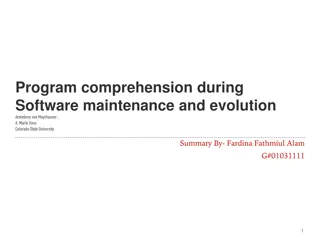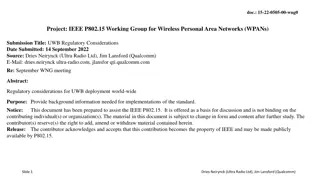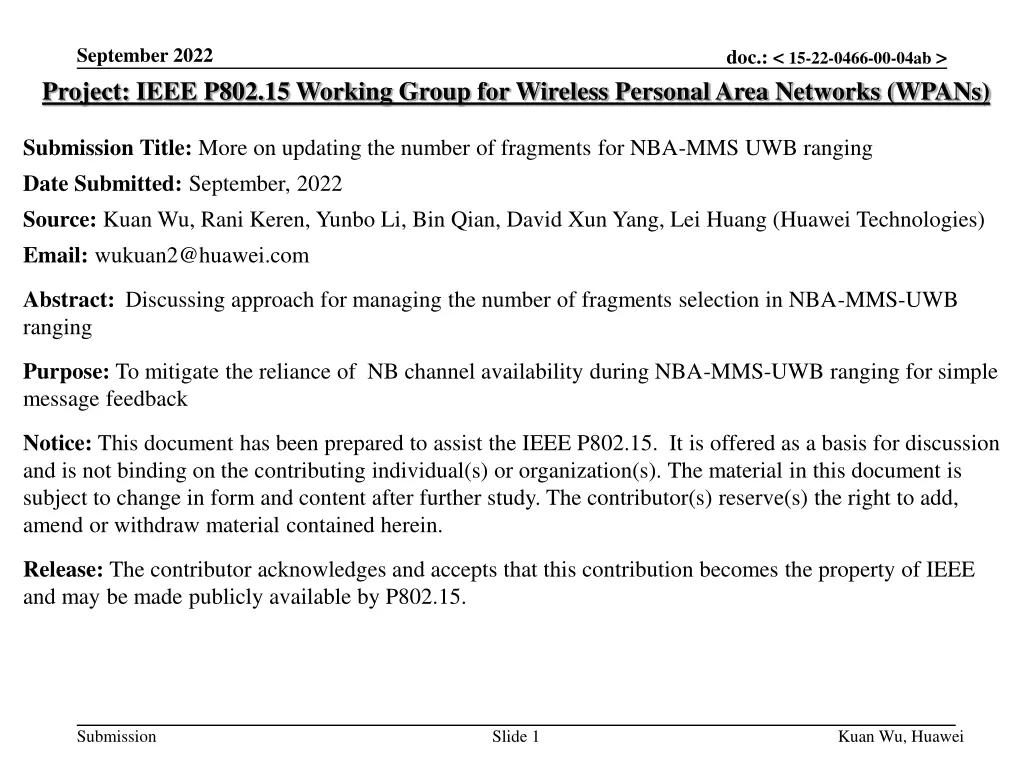
Managing Fragment Selection in NBA-MMS UWB Ranging
Discussing a strategy to manage the number of fragments for improving NBA-MMS UWB ranging by reducing reliance on NB channel availability for better message feedback. The document addresses interference mitigation, coexistence improvement, accuracy enhancements, and low-power streaming support in IEEE P802.15 WPANs. Various contributions and related proposals are also highlighted in the submission.
Download Presentation

Please find below an Image/Link to download the presentation.
The content on the website is provided AS IS for your information and personal use only. It may not be sold, licensed, or shared on other websites without obtaining consent from the author. If you encounter any issues during the download, it is possible that the publisher has removed the file from their server.
You are allowed to download the files provided on this website for personal or commercial use, subject to the condition that they are used lawfully. All files are the property of their respective owners.
The content on the website is provided AS IS for your information and personal use only. It may not be sold, licensed, or shared on other websites without obtaining consent from the author.
E N D
Presentation Transcript
September 2022 Project: IEEE P802.15 Working Group for Wireless Personal Area Networks (WPANs) doc.: < 15-22-0466-00-04ab > Submission Title: More on updating the number of fragments for NBA-MMS UWB ranging Date Submitted: September, 2022 Source: Kuan Wu, Rani Keren, Yunbo Li, Bin Qian, David Xun Yang, Lei Huang (Huawei Technologies) Email: wukuan2@huawei.com Abstract: Discussing approach for managing the number of fragments selection in NBA-MMS-UWB ranging Purpose: To mitigate the reliance of NB channel availability during NBA-MMS-UWB ranging for simple message feedback Notice: This document has been prepared to assist the IEEE P802.15. It is offered as a basis for discussion and is not binding on the contributing individual(s) or organization(s). The material in this document is subject to change in form and content after further study. The contributor(s) reserve(s) the right to add, amend or withdraw material contained herein. Release: The contributor acknowledges and accepts that this contribution becomes the property of IEEE and may be made publicly available by P802.15. Submission Slide 1 Kuan Wu, Huawei
September 2022 doc.: < 15-22-0466-00-04ab > PAR Objective Proposed Solution (how addressed) Safeguards so that the high throughput data use cases will not cause significant disruption to low duty-cycle ranging use cases Interference mitigation techniques to support higher density and higher traffic use cases Other coexistence improvement Backward compatibility with enhanced ranging capable devices (ERDEVs) Improved link budget and/or reduced air-time Discussion on the number of fragments for NBA-MMS UWB Additional channels and operating frequencies Improvements to accuracy / precision / reliability and interoperability for high-integrity ranging Reduced complexity and power consumption Hybrid operation with narrowband signaling to assist UWB Discussion on alleviating the reliance on NB channel availability for conveying simple messages Enhanced native discovery and connection setup mechanisms Sensing capabilities to support presence detection and environment mapping Low-power low-latency streaming Higher data-rate streaming allowing at least 50 Mbit/s of throughput Support for peer-to-peer, peer-to-multi-peer, and station-to- infrastructure protocols Infrastructure synchronization mechanisms Submission Slide 2 Kuan Wu, Huawei
September 2022 doc.: < 15-22-0466-00-04ab > Related Contributions [1] 15-22-0381-00-04ab-nba-uwb-ranging-text-proposal-for-15-4ab-tfd (July, 2022) , Yong Liu et al [2] 15-22-0378-00-04ab-on-the-selection-of-number-of-fragments-in-mms-uwb (July, 2022) , Rani Keren, Kuan Wu et al Submission Slide 3 Kuan Wu, Huawei
September 2022 doc.: < 15-22-0466-00-04ab > Introduction If Listen-before-Talk (LBT) is required before a narrowband (NB) transmission in the corresponding operating band, a transmitter shall perform LBT in advance of the start of the expected transmission [1]. Observation: The implementation of narrowband-assisted multi-millisecond (NBA-MMS) ranging is subject to the availability of NB channels Low robustness Submission Slide 4 Kuan Wu, Huawei
September 2022 doc.: < 15-22-0466-00-04ab > Introduction (cont.) On the selection of number of fragments in an MMS-UWB [2] Option 1: Dynamic update of the # of fragments. e.g., Dynamic update of the # of fragments at the report phase Option 2: Fixed selection preconfigured to the largest number of fragments. Observations: Updating the number of fragments within the MMS measurement phase has not yet been discussed [2]. The updating message by NB feedback at any phases suffers the aforementioned robustness problem. Submission Slide 5 Kuan Wu, Huawei
September 2022 doc.: < 15-22-0466-00-04ab > Motivation & Proposals During transmission of MMS fragments, enable the receiving side to request an early termination of the MMS procedure in case the number of fragments it has already received is sufficient for a reliable ranging measurement. This approach may result in a faster and more fluent adaptation to changing channel conditions: Transmission of redundant fragments is not required in case channel conditions improve and require less fragments than the pre-configured number of fragments. By setting the pre-configured number of fragments to be higher than required by current channel conditions, a sufficient number of fragments may immediately apply once channel conditions are degraded. This avoids failed MMS procedures with insufficient number of fragments during the response to the degrading conditions. To mitigate the reliance of NB channel availability during MMS ranging for simple message feedback Indicating the change of the number of fragments by non-NB method. Also extended to serve other simple messages Maintaining preamble-only structure non-data packets to convey the feedback message Submission Slide 6 Kuan Wu, Huawei
September 2022 doc.: < 15-22-0466-00-04ab > The feedback is conveyed by the change of preambles (Symmetric case) Instead of using NB signals, maintaining preamble-only packet structure to indicate the change of the number of fragments within the same round. (a) Originally with 8 fragments for the channel sounding (b) Feedback that received fragments are sufficient for processing The change from Preamble 1 to Preamble 2 indicates that the number of fragments is sufficient for aggregation processing, further fragments are no longer needed. The change operation is jointly determined by both sides (initiator/responder) Two-way manner can serve as an ack mechanism for confirming to the other side that the change message has been successfully interpreted. In case the responding side misses/mis-detects the packet with preamble 2 The initiator repeats the transmission of preamble 2 until the responding side detects it or until the transmitted number of fragments reaches the max allowed number. The responder repeats the transmission of preamble 1 until it successfully detects preamble 2 or until the transmitted number of fragments reaches the max allowed number. Submission Slide 7 Kuan Wu, Huawei
September 2022 The feedback is conveyed by the change of preambles (Symmetric case) (cont.) For the ease of the receiving side, the responder may optionally detect whether there is any change of preamble only at some specific timing check points (Optional). Avoiding frequent detections with multiple correlations for different preambles at the responder side to reduce false detection probability of preamble types at the receiver side. doc.: < 15-22-0466-00-04ab > Specifying check-points to detect the preamble changes, for example at slot 4 and 8 Submission Slide 8 Kuan Wu, Huawei
September 2022 The feedback is conveyed by the change of preambles (Asymmetric case) doc.: < 15-22-0466-00-04ab > The change operation is implemented by each side (initiator/responder) separately In case the noise levels between initiator and responder differ greatly Submission Slide 9 Kuan Wu, Huawei
September 2022 doc.: < 15-22-0466-00-04ab > Summary Implicit method to indicate number of fragments without explicit NB indication to alleviate the reliance on NB channel availability The use of UWB preamble-only packets/non-data packets method A candidate method to provide simple message feedbacks when NB channels are unavailable Indicating the change of the number of fragments by changing the preamble Specifying time check points for the ease of the receiving side The change operation can be operated symmetrically or asymmetrically Submission Slide 10 Kuan Wu, Huawei

